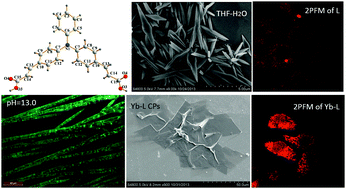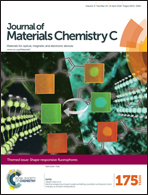Effect of solvent, pH and metal ions on the self-assembly process and optical properties of an A–π–D–π–A type triphenylamine carboxylic acid derivative†
Abstract
A ‘Λ’ structural A–π–D–π–A type triphenylamine derivative (2E,2′E)-3,3′-(4,4′-(phenylazanediyl)bis(4,1-phenylene))diacrylic acid (abbreviated as L) with intramolecular charge transfer (ICT) character has been designed, synthesized and characterized. The morphology and linear optical properties of L nanostructures can be tuned by changing the solvent and/or the acidity of the solution. The possible growth mechanism is discussed through the single crystal structure and the corresponding molecular stacking style of L molecules. Further, the strong coordination effect between the carboxylic acid group of L and the metal ions is discussed, which also brings about changeable morphology, linear optical properties and enhanced nonlinear optical properties, two photon absorbance (TPA) included, which makes them suitable for applications in two-photon biological imaging, such as in HepG2 cells.

- This article is part of the themed collection: Shape-Responsive Fluorophores

 Please wait while we load your content...
Please wait while we load your content...